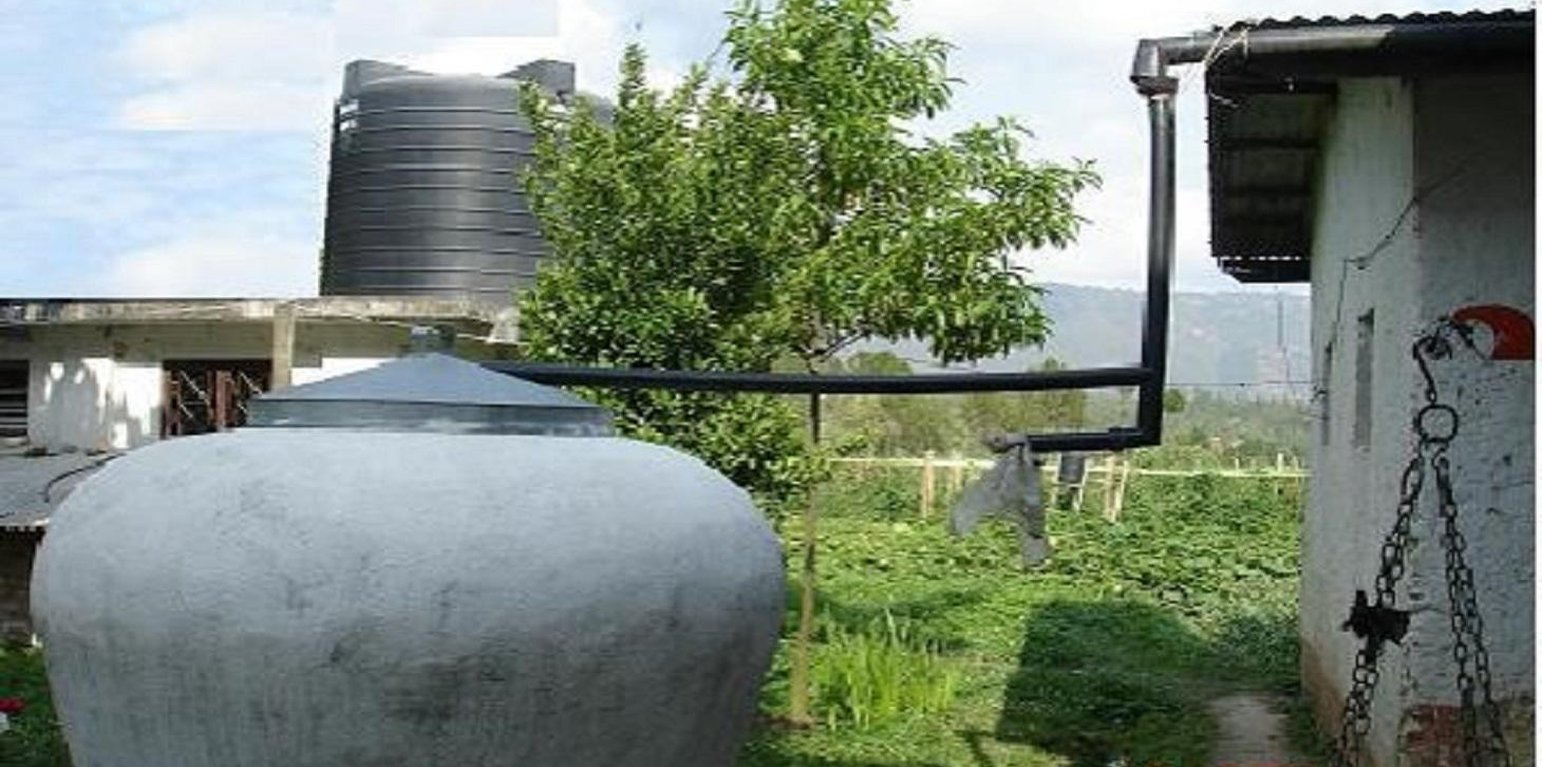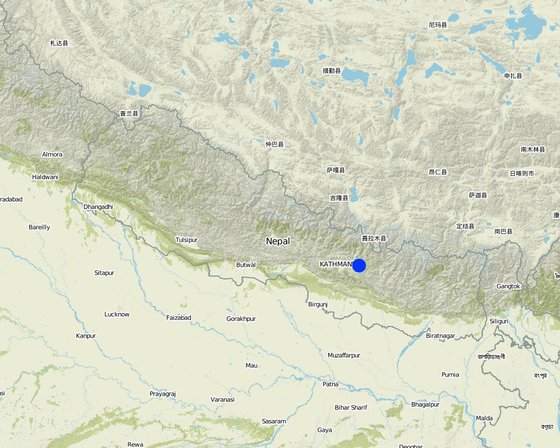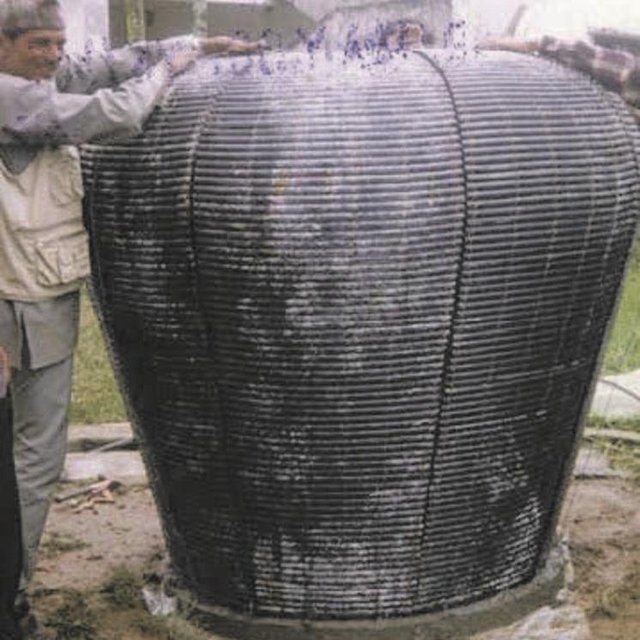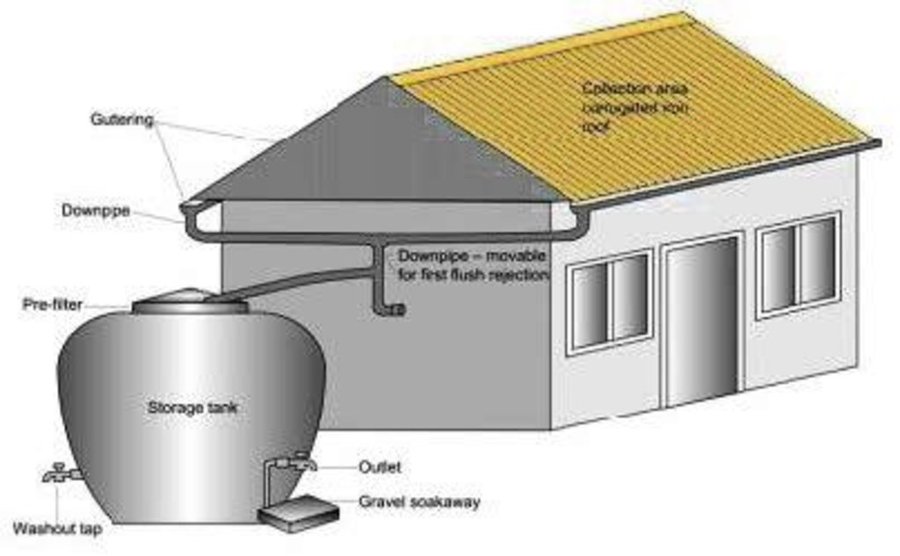



Many households in Nepal’s midhills suffer from water shortages during the pronounced dry season. The technology described here - harvesting roofwater during times of heavy rainfall for later use - is a promising way of improving people’s access to water for household use, especially for households with no or only limited access to spring or stream water. The technology has yet to be extensively adopted in Nepal’s midhills.
Purpose of the Technology: The technology was introduced in the Jhikhu Khola watershed to demonstrate an alternative source of water for domestic use (mainly drinking water). This technology is appropriate for scattered rural households in mountaineous areas. The harvesting system consists of a catchment roof, conveyance pipes, and a storage jar. The pipes include a gutter system made from longitudinally split polythene pipe which has a flushing system that allows the system to be periodically flushed clean.
The collected water enters a 500 or 2000 litre capacity ferro-cement jar made using a mould (see photo). A preconstructed mould made from iron rods and polythene pipes is installed on a concrete base plate. Metal wires are extended from the base plate over the main mould to the top. Chicken mesh is then wrapped over the mould and tied securely with thin wire. A cement coating is applied over the metal structure. The jar is finished with three coatings of cement and the opening is covered with a fine nylon mesh to filter out undesired coarse matter. A tin lid is placed over the top.
Establishment / maintenance activities and inputs: A tap is fixed about 20 cm above the ground. This height allows for water to be collected in the typical 15 litre local water vessels (gagri) and avoids collection of too much water in bigger vessels as well as minimising the dead storage of water (Nakarmi et al. 2003). Trained masons can easily install the entire system. Provided all the materials and the mould are available, the entire system can be put together in about a week. The main maintenance task is to keep the roof clean, especially after long dry periods. This is done using the gutter pipe flushing system in which the first dirty water from the roof is diverted away from the jar.

地点: Kavrepalanchowk district, Kharelthok, Sathighar, Panchkhal, Hokse and Patalekhet VDCs of the Jhikhu Khola watershed, 尼泊尔
分析的技术场所数量:
技术传播: 适用于特定场所/集中在较小区域
在永久保护区?:
实施日期: 不到10年前(最近)
介绍类型




| 对投入进行具体说明 | 单位 | 数量 | 单位成本 (美元) | 每项投入的总成本 (美元) | 土地使用者承担的成本% |
| 劳动力 | |||||
| Construction of rooftop rainwater harvesting system | Persons/unit | 19.5 | 2.1 | 40.95 | 25.0 |
| 施工材料 | |||||
| Cement | unit | 1.0 | 23.6 | 23.6 | |
| Sand and aggregate | unit | 1.0 | 1.4 | 1.4 | 100.0 |
| Chicken wire mesh | unit | 1.0 | 20.9 | 20.9 | |
| Metal jar cover | unit | 1.0 | 5.5 | 5.5 | |
| Plastic sheet/mosquito screen | unit | 1.0 | 1.5 | 1.5 | |
| Polyethylene, pipes, reducer | unit | 1.0 | 23.7 | 23.7 | |
| Nail, clamps, pipe elbow etc. | unit | 1.0 | 3.6 | 3.6 | |
| Brass tap. socket, seal tap | unit | 1.0 | 3.5 | 3.5 | |
| 其它 | |||||
| Paint | unit | 1.0 | 2.1 | 2.1 | |
| 技术建立所需总成本 | 126.75 | ||||
| 技术建立总成本,美元 | 126.75 | ||||
| 对投入进行具体说明 | 单位 | 数量 | 单位成本 (美元) | 每项投入的总成本 (美元) | 土地使用者承担的成本% |
| 劳动力 | |||||
| Cleaning the system | Persons/unit | 7.0 | 2.1 | 14.7 | 100.0 |
| 技术维护所需总成本 | 14.7 | ||||
| 技术维护总成本,美元 | 14.7 | ||||
by the house to accommodate the water jar
in dry seasons
harvested water can be used during busy periods ( field preparation, vegetable planting, rice harvesting, and festivals).
SLM之前的数量: 1 hour
SLM之后的数量: 5 minutes
greatly reduced time needed to fetch water
reduced women's workload i.e. per day water fetching time reduced from about 12 hours to about 1 hour ( for the households having ~10 family members).
A house hold having 10 family member require about 12 gagree ( 1 gagree is equivalent to15 litre)
together with adopters, other potential local adopters have started discussing options
through training, demonstration, and knowledge sharing
Improved heath condition due to clean water availability
more water avilable forwashing leading to improved health
a little portion of rainfall traped directly from the roof and collected at the courtyard
reduced eroded materials from the courtyard.